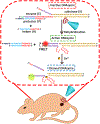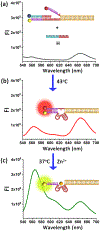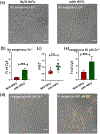Noninvasive and Spatiotemporal Control of DNAzyme-Based Imaging of Metal Ions In Vivo Using High-Intensity Focused Ultrasound
- PMID: 35302361
- PMCID: PMC9133526
- DOI: 10.1021/jacs.1c11543
Noninvasive and Spatiotemporal Control of DNAzyme-Based Imaging of Metal Ions In Vivo Using High-Intensity Focused Ultrasound
Abstract
Detecting metal ions in vivo with a high spatiotemporal resolution is critical to understanding the roles of the metal ions in both healthy and disease states. Although spatiotemporal controls of metal-ion sensors using light have been demonstrated, the lack of penetration depth in tissue and in vivo has limited their application. To overcome this limitation, we herein report the use of high-intensity focused ultrasound (HIFU) to remotely deliver on-demand, spatiotemporally resolved thermal energy to activate the DNAzyme sensors at the targeted region both in vitro and in vivo. A Zn2+-selective DNAzyme probe is inactivated by a protector strand to block the formation of catalytic enzyme structure, which can then be activated by an HIFU-induced increase in the local temperature. With this design, Zn2+-specific fluorescent resonance energy transfer (FRET) imaging has been demonstrated by the new DNAzyme-HIFU probes in both HeLa cells and mice. The current method can be applied to monitor many other metal ions for in vivo imaging and medical diagnosis using metal-specific DNAzymes that have either been obtained or can be selected using in vitro selection.
Conflict of interest statement
The authors declare no competing financial interest.
Figures





References
-
- Kozlowski H; Janicka-Klos A; Brasun J; Gaggelli E; Valensin D; Valensin G Copper, iron, and zinc ions homeostasis and their role in neurodegenerative disorders (metal uptake, transport, distribution and regulation). Coord. Chem. Rev 2009, 253, 2665–2685.
-
- Böhme S; Baccaro M; Schmidt M; Potthoff A; Stärk H-J; Reemtsma T; Kühnel D Metal uptake and distribution in the zebrafish (Danio rerio) embryo: differences between nanoparticles and metal ions. Environ. Sci.: Nano 2017, 4, 1005–1015.
-
- Brun NR; Lenz M; Wehrli B; Fent K Comparative effects of zinc oxide nanoparticles and dissolved zinc on zebrafish embryos and eleuthero-embryos: Importance of zinc ions. Sci. Total Environ 2014, 476–477, 657–666. - PubMed
Publication types
MeSH terms
Substances
Grants and funding
LinkOut - more resources
Full Text Sources

